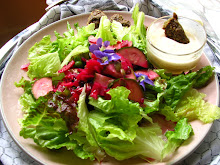
A sweet and a lemony dressing accompany this lunch:
1) Lemon-Garlic Tahini for dipping the zucchini sun-breads and
2) Sweet beet and onion dressing over the John Goode's baby romaine.
Top it off with fresh-picked wild violets. Use some of the smaller lighter-green new leaves from the violets as part of your mix for salad greens. Yum!

All ingredients are local, when available, and ALWAYS organic or home-grown using organic methods.
Lemon Garlic Tahini Dip:
Ingredients:
- juice of one lemon
- 1 tsp of Cooper's local clover honey*
- 1/8 tsp Himalayan pink salt*
- 1 and 1/2 cups of hulled organic sesame seeds*
- 2-3 cloves of garlic, to taste
- clean source water for soaking seeds and as needed (up to 1/4 cup)
* Available on the shelf at Kovac's North in the produce section, 2201 Frederick Ave. St. Joseph, MO 64507.
John Goode's gorgous greens available through freshconnectkc.com
Instructions:
Soak sesame seeds 4 hours at room temp or overnight in fridge. Drain, rinse and allow to rest, wet, for a minimum of 4 hours in the dark. (One method is to use a dish or crock that does not allow light to pass through. Cover the dish with a plate as it's lid. Another method is to use a glass jar and place it inside a double layered brown grocery bag.) Expose to sun-light for 10 to 15 minutes, optional. Rinse one more time before adding to recipe.
Add soaked seeds with all other ingredients to the food processor or Vitamix. Only use water, if needed. Blend until smooth. Chill or store in fridge. Use as a dip for sun-breads and living seed crackers; To use as a salad dressing, add raw or toasted sesame oil and more citrus juice (lemon, orange or lime are all good!) Also used as an ingredient in hummus.
Sweet-Beet Dressing/Marinade
Ingredients:
- 1 cup Raw Oil of Choice (Safflower, Sunflower, Raw Sesame, Walnut, Grape-seed, Pumpkin Seed, Extra Virgin Olive are all good raw bases)
- 1/2 cup raw apple cider vinegar
- 1/4 cup grade B maple syrup
- 1/2 large yellow onion, dices
- 1-2 cloves crushed garlic, to taste
- about 1/4 cup of diced beets = center cut of one small beet
- a pinch of Himalayan sea salt (optional) -some oils, like olive oil, do not require extra salt
- fresh garden herbs
Instructions:
Making this dressing the day before you use it mellows the flavors and results in extra bright colors.
TIP
Instead of peeling the beet, just carve a square out of the middle and use the outer pieces (peel in-tact) to run through the juicer. Add the juice to the dressing. Or, just drink it. You can also add other veggies to the juicer to make a full glass of veggie juice (I like combining celery, apples, sweet-potatoes or the stems from kale or chard with the beet. You will be surprised how a little beet-juice goes a long way!)
Add the ingredients to a glass jar, shake it and refrigerate until ready to use. The yellow onion will turn bright pink and translucent. All other veggies and herbs to your liking. Zuchini, cucumber, diced carrots, spring radishes, sweet corn and pumpkin seeds are all good choices.
Warm the sun bread in 75+ degrees in the sun under a bug-screen or pop them in the dehydrator at 105 degrees for 10 to 15 minutes. Serve with chilled Tahni dip.
To assemble the salad: harvest baby romaine, wash and pat dry the leaves. Put tiwce as much on your plate as you normally would. Toss or top with dressing, edible flowers, freshly-shucked peas and anything else young and green and cute you can find!
 A sweet and a lemony dressing accompany this lunch:
A sweet and a lemony dressing accompany this lunch: All ingredients are local, when available, and ALWAYS organic or home-grown using organic methods.
All ingredients are local, when available, and ALWAYS organic or home-grown using organic methods.












